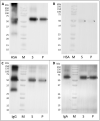Proteins in human body fluids contain in vivo antigen analog of the melibiose-derived glycation product: MAGE
- PMID: 35525899
- PMCID: PMC9079080
- DOI: 10.1038/s41598-022-11638-2
Proteins in human body fluids contain in vivo antigen analog of the melibiose-derived glycation product: MAGE
Abstract
Melibiose-derived AGE (MAGE) is an advanced glycation end-product formed in vitro in anhydrous conditions on proteins and protein-free amino acids during glycation with melibiose. Our previous studies revealed the presence of MAGE antigen in the human body and tissues of several other species, including muscles, fat, extracellular matrix, and blood. MAGE is also antigenic and induces generation of anti-MAGE antibody. The aim of this paper was to identify the proteins modified by MAGE present in human body fluids, such as serum, plasma, and peritoneal fluids. The protein-bound MAGE formed in vivo has been isolated from human blood using affinity chromatography on the resin with an immobilized anti-MAGE monoclonal antibody. Using mass spectrometry and immunochemistry it has been established that MAGE epitope is present on several human blood proteins including serum albumin, IgG, and IgA. In serum of diabetic patients, mainly the albumin and IgG were modified by MAGE, while in healthy subjects IgG and IgA carried this modification, suggesting the novel AGE can impact protein structure, contribute to auto-immunogenicity, and affect function of immunoglobulins. Some proteins in peritoneal fluid from cancer patients modified with MAGE were also observed and it indicates a potential role of MAGE in cancer.
© 2022. The Author(s).
Conflict of interest statement
The authors declare no competing interests.
Figures




Similar articles
-
Analysis of the Site-Specific Myoglobin Modifications in the Melibiose-Derived Novel Advanced Glycation End-Product.Int J Mol Sci. 2022 Oct 27;23(21):13036. doi: 10.3390/ijms232113036. Int J Mol Sci. 2022. PMID: 36361822 Free PMC article.
-
The melibiose-derived glycation product mimics a unique epitope present in human and animal tissues.Sci Rep. 2021 Feb 3;11(1):2940. doi: 10.1038/s41598-021-82585-7. Sci Rep. 2021. PMID: 33536563 Free PMC article.
-
The Genotoxic and Pro-Apoptotic Activities of Advanced Glycation End-Products (MAGE) Measured with Micronuclei Assay Are Inhibited by Their Low Molecular Mass Counterparts.Genes (Basel). 2021 May 13;12(5):729. doi: 10.3390/genes12050729. Genes (Basel). 2021. PMID: 34068126 Free PMC article.
-
Endogenous alpha-oxoaldehydes and formation of protein and nucleotide advanced glycation endproducts in tissue damage.Novartis Found Symp. 2007;285:229-43; discussion 243-6. doi: 10.1002/9780470511848.ch17. Novartis Found Symp. 2007. PMID: 17590998 Review.
-
Receptor Mediated Effects of Advanced Glycation End Products (AGEs) on Innate and Adaptative Immunity: Relevance for Food Allergy.Nutrients. 2022 Jan 15;14(2):371. doi: 10.3390/nu14020371. Nutrients. 2022. PMID: 35057553 Free PMC article. Review.
Cited by
-
Analysis of the Site-Specific Myoglobin Modifications in the Melibiose-Derived Novel Advanced Glycation End-Product.Int J Mol Sci. 2022 Oct 27;23(21):13036. doi: 10.3390/ijms232113036. Int J Mol Sci. 2022. PMID: 36361822 Free PMC article.
-
The association between advanced glycation end products (AGEs) and ABC (hemoglobin A1C, blood pressure, and low-density lipoprotein cholesterol) control parameters among patients with type 2 diabetes mellitus.Diabetol Metab Syndr. 2022 Aug 26;14(1):122. doi: 10.1186/s13098-022-00895-w. Diabetol Metab Syndr. 2022. PMID: 36028845 Free PMC article.
-
Alcoholic Liver Disease Is Associated with Elevated Plasma Levels of Novel Advanced Glycation End-Products: A Preliminary Study.Nutrients. 2022 Dec 10;14(24):5266. doi: 10.3390/nu14245266. Nutrients. 2022. PMID: 36558425 Free PMC article.
References
-
- Pietkiewicz J, Seweryn E, Bartys̈ A, Gamian A. Receptory końcowych produktów zaawansowanej glikacji-znaczenie fizjologiczne i kliniczne. Postepy Higieny i Medycyny Doswiadczalnej. 2008;62:511–523. - PubMed
Publication types
MeSH terms
Substances
LinkOut - more resources
Full Text Sources
Miscellaneous

